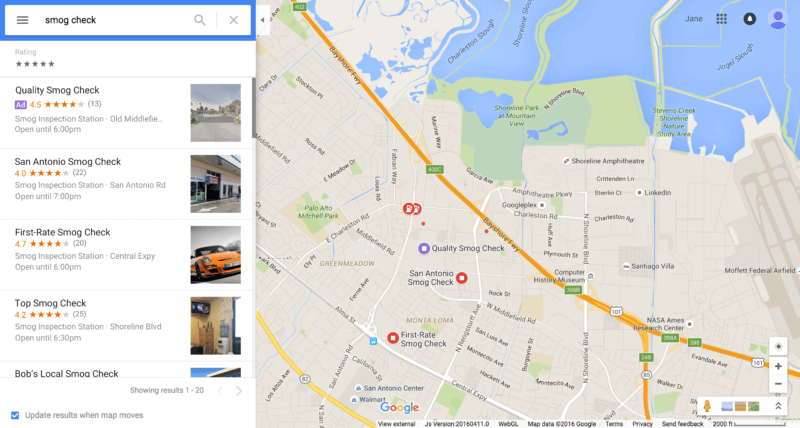Google Maps ads are changing to help local businesses become more visible. Columnist Will Scott discusses the four features you should be most excited about.

As an avid Google Maps user on both a personal and business level, I’ve often wished for a more interactive and all-inclusive experience. For instance, wouldn’t it be great to get suggestions for options like the closest coffee shop or lunch spot while I’m driving from Point A to Point B? Sure, I could pull over, open up Google and search for these things separately, but who wouldn’t welcome a truly responsive and local experience within Google Maps?
If you’re like me, then Google’s recent announcements for local businesses are good reason to celebrate. These revamped Maps ads are primarily focused on helping local businesses drive more traffic to their physical locations. According to Google, its new Maps ads will help businesses increase their visibility at times when consumers are specifically searching for somewhere to shop or eat.
As a consumer, marketing professional or business owner, why should you be excited about these new Google Maps ads? Because they’re valuable to both consumers and business owners: The new ads will not only help consumers find the businesses they’re looking for, they’ll also get additional information about each business. The ads are designed to give local businesses additional opportunities to feature their brands with the goal of increasing traffic, particularly when consumers are searching on a mobile device.
For example, if a consumer is driving on the freeway following a Google Maps route and desperately needs a caffeine fix, they could look for a “coffee shop near me” in the Google Maps app search bar. A coffee shop that paid to have an ad appear would come up first in the search results list, and its logo would appear on the map in its physical location.
These company logos, also called promoted pins, are one of the most exciting new features. If this isn’t enough to make you jump for joy, please take a few moments to explore in greater detail the following four reasons why Google’s new Maps ads will thrill you.
1. New local search ads
Google’s new local search ads are currently available to advertisers using location extensions in AdWords. These ads will appear on Google Maps for desktop and the Google Maps mobile app. For those of us who work in the marketing world, this is extra exciting, as the Google Maps app alone has over one billion downloads and thus reaches vast numbers of potential consumers.
When users search on Google Maps for desktop, they will see Google Maps ads in the Local Finder above all other map results, this time with purple ad labels. The map also will note these locations with purple pins.

Similarly, users with the Google Maps mobile app installed will see the purple ad labels and map pins for businesses using local search ads. Like the organic listings, these local ads may include “Call” and “Directions” buttons.
This can be extremely impactful for small businesses that are looking to rank locally for relevant searches but have not been successful in trying to rank organically in local maps results.
2. Promoted Pins
In a recent blog post, Google explained that the primary goal of its Maps changes is to help marketers bring together the digital and physical universes, particularly because location searches on mobile devices have grown an astounding 50 percent more quickly than all other types of mobile searches.
This next part is where you should really get excited. Google is completely optimizing the entire Google Maps adventure with promoted pins, or more simply, company logos that will indicate physical locations on Google Maps for companies that buy ad space. Users will see these pins when they have a Google Map pulled up, when getting directions, and even during navigation while they’re driving. The pins will be designed to be simple and unobtrusive to avoid distracting drivers behind the wheel.

In the app, ads will show up with distinctive purple ad labels and will be prominently featured in the first spot above organic search results. If you’re searching within Google Maps, no more than two ads with purple ad labels will make it to the top of the results, so getting that top placement is significant.
3. In-store promotions
Now that I’ve established why I’m so excited about promoted pins, let’s take it a step further so you can learn about another user-friendly feature for in-store promotions. With promoted pins, businesses are able to feature specials that are happening right now at that location, displaying the in-store promotion below the logo on the map itself.
For example, the logo for Starbucks could come up while you’re driving, following your on-screen directions, displaying a $1-off coupon. Thinking about how tired you are, you tap on the logo and the business page will come up on the bottom of your screen, displaying coupons, specials or in-store promotions happening right now at that location. The potential to bring in new customers thanks to this feature is unlimited, as the right promotion could easily propel more store visits.
4. Customizable business pages with local inventory
Even better, for advertisers using promoted pins, local business pages can be customized with the same goal to increase physical visits to stores. Consider the potential of having the flexibility to highlight offers towards customers who are in your area and looking for exactly what you sell. Local business pages will still include essential business information such as operating hours, address and phone number, but now they can feature the in-store promotions previously mentioned.
Customizable business pages will also highlight searchable local inventory. Google’s research found one out of every four people will avoid visiting stores when they don’t know if the product they’re looking for is in stock, which propelled them to add this useful feature. So now customized business pages can be set up to allow users to search for items in a store’s inventory. How does this work? Businesses will provide Google with their inventory feed, and customers will be able to do searches of that inventory to determine what is in stock.
Since in-store traffic is the goal of these local maps ads, Google is working to enhance accuracy of tracking store visits conversions using beacons. While currently only available to select businesses (There are certain requirements), they are hoping to be able to allow all advertisers to attribute ad dollars to offline metrics to better determine ROI of online efforts.
So what can you do now while the excitement builds for these changes? If you haven’t already, claim your business page on Google My Business and ensure the information is accurate and complete. Inaccurate information will make it much more difficult for people to act on their shopping instincts and visit a physical location.
Then, set up location extensions for your Google AdWords search campaigns so your ads will be eligible to appear on all Maps results. Until store visit metrics are available for all businesses, the information provided about your location extensions, such as clicks on the “Get Directions” link, can be an indicator of how well your ads are working to drive traffic to your store.
What do you think about the new Google Maps ads? Let me know on social media.
[Article on Search Engine Land.]
Some opinions expressed in this article may be those of a guest author and not necessarily Marketing Land. Staff authors are listed here.
Marketing Land – Internet Marketing News, Strategies & Tips
(54)
Report Post







